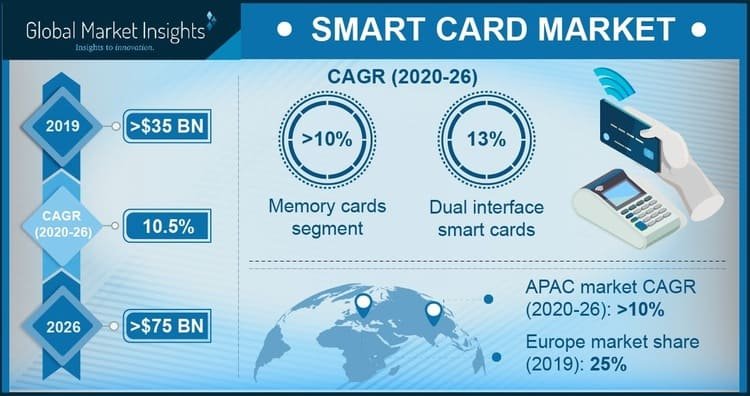Global Smart Cards Market Size To Hit $75bn by 2026

The global smart card market is estimated to observe considerable revenue growth majorly due to robust demand for secure and safe payment transactions across the retail sector. There is a massive risk of cyberattacks in the retail and transportation sector. Smart cards are vital across these landscapes as they can be used for checking employee identity as well as citizen records easily.
Along with increased security, data integrity provided by smart cards could play an important role in increasing its adoption across various industries. In addition to data integrity, the product also provides enhanced flexibility as it can store information regarding identification, credit cards, and family and business contacts. Considering these offered benefits, Global Market Insights, Inc., estimates that the global smart card market is likely to surpass a valuation of $75 billion by the end of 2026.
Mentioned below is an overview of the top trends influencing global smart card market:
- Growing product sales by POS manufacturers:
Several Point-of-Sale (POS) manufacturers are working on integrating their products with advanced technology, fuelling smart card industry growth. POS manufacturers are focusing on developing advanced solutions that combine functions like sales & order management, employee management, and warehouse management.
POS combined with smart card features enable retailers to offer value-added shopping experience to consumers. Additionally, POS solutions drive consumer satisfaction as well as enables retailers to efficiently expand their consumer base.
- Robust demand for hybrid cards:
Hybrid cards are increasingly being deployed for access and control needs across colleges, schools, offices, and campuses. These cards are equipped with a microprocessor smart card chip as well as one contactless RFID proximity chip that has no interface.
Hybrid cards provide individuals with safe access to authorized areas. These cards are also utilized as identification cards for ticketing purposes in public transports. The product eliminates the waiting time at the authorization point, thereby increasing user satisfaction.
- Increasing demand across Latin America
Rise in the number of foreign banks across Latin America is touted to propel EVM card adoption. Government agencies in Latin America are increasingly aiming at deploying contactless technology throughout regional public transportation.
Along with this, various government declared funds and initiatives are providing a viable gaining ground for the regional smart card market. Taking October 2018 for instance, the Brazilian government launched a pilot program that started mobile NFC based ticketing across Rio de Janeiro for city public transport. Smartphones were used as digital wallets having NFC technology to make secure payments while ticketing. Furthermore, other key cities in Brazil like Sao Paulo, Santiago, Buenos Aires, Lima and Bogota have deployed Automatic Fare Collection (AFC) systems for public transport.
While globally, mounting initiatives by several governments to replace traditional payment methods with smart cards technology is propelling product share. Taking March 2020 for instance, the City of Lucknow in India revealed plans to unveil a new scheme called ‘One City, One Card’. Under this program, citizens would be allowed to pay for electricity bills, e-challans, water tax, parking charges, metro, and bus fare, using a single smart card.
About the Author:
A qualified computer graduate, Bhushan Tambe always nurtured a passion for words. Post his education, he decided to transform his penchant of penning down poetry and stories into a full-time career. Presently, Bhushan writes numerous articles on subjects spanning business, finance, the automotive and industrial landscapes, and the like.